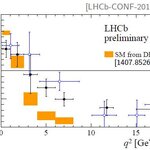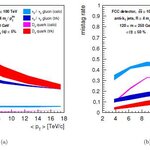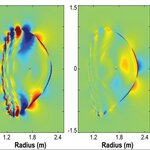Physics

Spring is finally in, and with it the great expectations for a new run of the Large Hadron Collider, which will restart in a month or so with a 62.5% increase in center of mass energy of the proton-proton collisions it produces: 13 TeV. At 13 TeV, the production of a 2-TeV Z' boson, say, would not be so terribly rare, making a signal soon visible in the data that ATLAS and CMS are eager to collect.
Several new physics signatures are going to benefit significantly from the energy increase, and not just a Z' boson. And who needs a Z' boson, after all: I am sometimes skeptical of this uncalled-…

It is often claimed that the Ancient Greeks were the first to identify objects that have no size, yet are able to build up the world around us through their interactions.
And as we are able to observe the world in tinier and tinier detail through microscopes of increasing power, it is natural to wonder what these objects are made of.
We believe we have found some of these objects: subatomic particles, or fundamental particles, which having no size can have no substructure. We are now seeking to explain the properties of these particles and working to show how these can be used to explain the…
By Ben P. Stein, Inside Science Currents Blog -- Last week, the Internet lit up with dramatic headlines from the world of science: In a Physics First, Light is Captured as Both Particle and Wave, Light Photographed as a Simultaneous Wave and Particle, and Light's Wave-Particle Duality Imaged For The First Time, to name a few.
These headlines sound revolutionary, surprising, profound to any of us with even just a passing knowledge of the concepts they mention. Quantum physics suggests that every object in the universe has a dual nature. A photon, the…

Uranium is the element having 92 protons in its nucleus with
typically 146 neutrons. It is the
largest naturally occurring element.
Like naturally occurring Thorium, uranium is radioactive and eventually
decays into radium and radon which are likewise radioactive. Both uranium and thorium decay through many series
of radioactive elements until they eventually become lead.
The process of radioactive decay follows a common yet generally
unfamiliar law known as exponential decay.
It is from this decay law that we get the term,
"half-life". The way this
works…

The top quark is the heaviest known elementary particle. It was discovered in 1995 by the CDF and DZERO experiments at the Fermilab Tevatron collider after a long hunt that had started almost two decades earlier: it took long because the top weighs as much as a whole silver atom, and producing this much matter in single particle-particle collisions is difficult: it requires collision energies that started to be available only in 1985, and the rarity of the production processes dictate collision rates that were delivered only in the early nineties.
When the top quark decays, it transforms its…

General Atomics, which operates the DIII-D National Fusion Facility for the U.S. Department of Energy, and the Department of Energy's Princeton Plasma Physics Laboratory (PPPL) have made a breakthrough in understanding how potentially damaging heat bursts inside a fusion reactor can be controlled.
The experiments with the DIII-D Fusion Facility, a tokamak in San Diego, represent a key step in predicting how to control heat bursts in future fusion facilities. Researchers have found that tiny magnetic fields applied to the device can create two distinct kinds of response, rather than…

Two photonic properties - spin and OAM1- have been teleported together for the first time ever. The breakthrough was achieved by Chaoyang Lu, Jian-Wei Pan and their team at University of Science and Technology of China, Hefei.
The team teleported the composite quantum states of a single photon encoded in both its spin and OAM1. For successful teleportation, three entangled pairs of photons were used.The entangled pairs were created by the usual method of shining a strong UV pulsed laser on three non-linear crystals.
Applications:
A platform for huge advancement in quantum communication and…

A research team from University of Leeds has figured out a way to kill cancer cells photothermally. They used Near-Infrared (NIR) to heat up gold nanotubes, and, a single-wavelength pulsed laser beam to rapidly increase the temperature near the nanotubes. This focussed, high-intensity heating kills the cancer cells.
A big advantage of the method is that NIR light has maximum penetration in the tissue without much harmful consequences. To minimize toxicity further, the gold nanotubes were coated with PSS - poly(sodium 4-styrenesulfonate).The team is led by Steve Evans of the School of Physics…

An international team of physicists have been able to reconstruct the first ever 3-D image of individual virus particles by tweaking the X-ray diffraction technique of nanocrystallography1
Cleverly bypassing the tedious procedure of crystallizing individual particles, the researchers targeted the virus (Acanthamoeba polyphaga mimivirus) with high-energy pulses (70 fs duration) from an X-ray free electron laser. The X-rays scattered from the virus bodies, creating a 2D diffraction pattern.Using 200 such different patterns and a mathematical algorithm to solve the problem of particle…

The XVI edition of Neutrino Telescopes is over and it is the time for some summing up – which I feel completely unsuited to do, as I was just an observer there. As you know, my field is high-energy collider physics, and neutrino physics has become a very different thing since the discovery of neutral currents 42 years ago. Anyway, I decided I would collect here a few random thoughts on the status of the field, as seen from my very skewed viewpoint...
First of all, I am really envious of the degree of activity, the large number of interesting experiments, the many complementary sides that can…